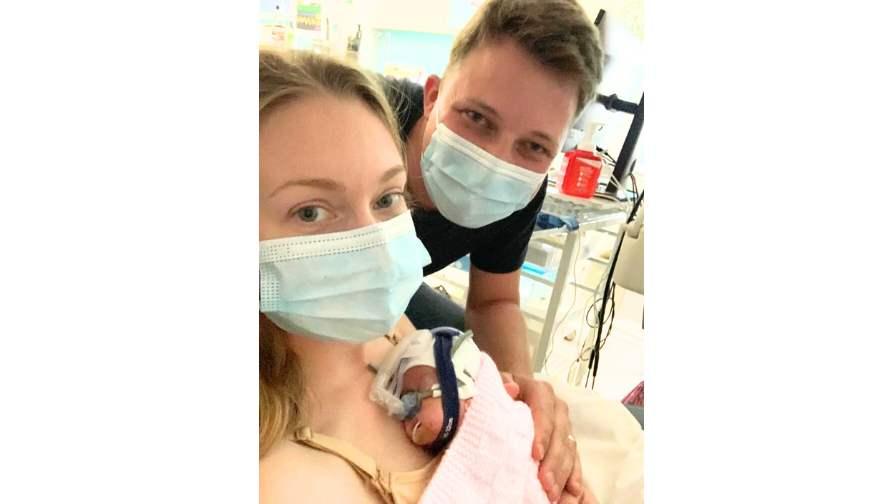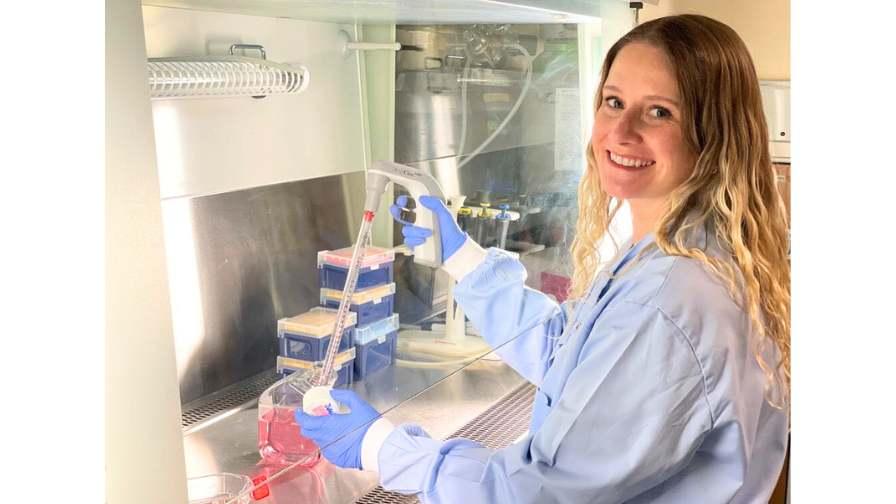Charities Action Medical Research and Borne are funding research at University College London (UCL) to develop an antimicrobial therapy to help prevent preterm birth in women who are considered high risk.
Evidence suggests that in some pregnant women, bacteria can pass into the womb, triggering inflammation and increasing the risk of early labour. The aim is that this new therapy will boost the effectiveness of specialised antimicrobial proteins, already present in the cervix, to help reduce the risk of preterm birth.
This research could help Debi Westcott whose daughter Elsie was born extremely early, when Debi’s waters broke at just 23 weeks. Debi remembers: “Elsie had to be delivered immediately and we were told that her chance of survival was just 1000 to 1. She was tiny and weighed less than a bag of sugar. Elsie spent almost seven months in the neonatal intensive care unit (NICU), which was scary and stressful, not just for me but also for my husband, Chris. Although Elsie is doing well and is walking and talking, I am concerned about having another premature baby.”

Elsie’s dad, Chris, comments: “As a dad you can feel helpless in a situation like this, so I set up a WhatsApp support group so I could speak to other men who have been or are going through the stress of life in the NICU. Elsie is doing really well but has to be monitored regularly as she has adrenal insufficiency which means that she doesn’t produce enough of the steroid hormone cortisol. This causes problems when she gets ill, so she has to be monitored and treated with steroids. The WhatsApp group is great and has really helped me.”
Dr Ashley Boyle and Professors Simon Waddington and Donald Peebles of UCL are investigating the anti-inflammatory and anti-bacterial effects of a new treatment, with and without progesterone, on cervical and vaginal cells in the laboratory. Dr Boyle explains, “Bacteria from the mother’s vagina can sometimes get through the neck of the womb – the cervix – and enter the womb where the baby is growing. Unfortunately, this can trigger inflammation that may cause harm to the baby and lead to premature birth.” More treatments are needed as the effectiveness of progesterone, which is the current approach recommended for women at high risk of preterm birth, is limited and not well understood.” This research will determine whether the new treatment can boost the production of one of the specialised antimicrobial proteins produced by the cervix – helping to stop bacteria from entering the womb. If successful, the work could lead to clinical trials.

Elsie is one of the 55,000 babies born prematurely each year in the UK and sadly more than 1,000 babies die each year after being born too soon.1,2,3,4,5 Many others who do survive are at increased risk of lifelong problems including cerebral palsy, blindness, hearing loss and learning difficulties. Although the causes of preterm birth remain poorly understood, an infection may be involved in four out of 10 women who experience an unexpected early labour.6

Dr Caroline Johnston, Senior Research Manager at Action Medical Research, says, “Research like this is vital to help tackle premature birth through deepening our understanding of why some babies are born too soon and move us closer to being able to develop new treatments that could prevent or delay early birth.”
Learn more about Action's work to tackle premature birth: www.action.org.uk/premature.
References
- Office for National Statistics, Vital statistics in the UK: births, deaths and marriages - 2021 https://www.ons.gov.uk/peoplepopulationandcommunity/populationandmigration/populationestimates/datasets/vitalstatisticspopulationandhealthreferencetables [website accessed 20 June 2023]
- National Institute for Health and Care Excellence - Preterm labour and birth final scope April 2013http://www.nice.org.uk/guidance/gid-cgwave0660/resources/preterm-labour-and-birth-final-scope2 [website accessed 20 June 2023]
- Office for National Statistics. Childhood mortality in England and Wales 2021. Table 4. Child mortality (death cohort) tables in England and Wales - Office for National Statistics (ons.gov.uk) 2021 data tables. Release date Mar2023 [website accessed 20 June 2023]
- National Records for Scotland. Vital Events Reference Tables 2021, Table 4.5: Infant Deaths by sex and cause, Scotland 2010 to 2021 List of Data Tables | National Records of Scotland (nrscotland.gov.uk) [website accessed 20 June 2023]
- Northern Ireland Statistics and Research Agency: Registrar General Annual Report 2020 Stillbirths and Infant Deaths, Table 4.5: Stillbirths and infant deaths by sex and cause, 2012 to 2020: Registrar General Annual Report 2020 Stillbirths and Infant Deaths | Northern Ireland Statistics and Research Agency (nisra.gov.uk) [website accessed 20 June 2023]
- Agrawal V. and Hirsch, E. Intrauterine infection and preterm labor. Semin Fetal Neonatal Med. 2012; 17(1):12-9
